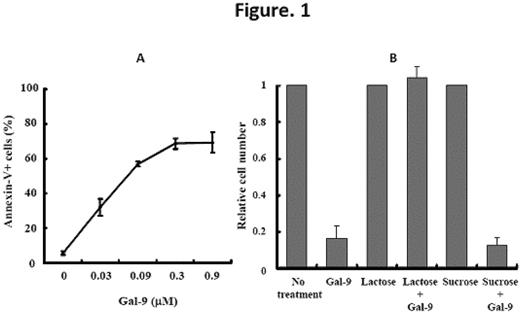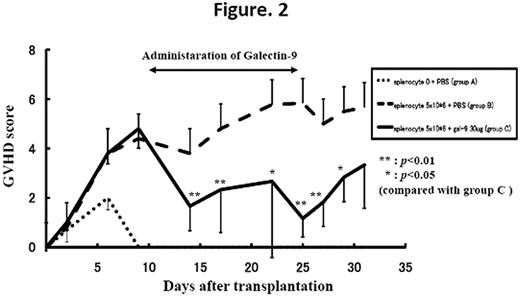Abstract
Abstract 1338
Poster Board I-360
Galectins are a family of soluble animal lectins that differ in their affinity for b-galactosides. Fifteen members of the human galectin family have been described to date. Galectin-9 (Gal-9) is a tandem-repeat-type galectin that was recently found to serve as a ligand for T cell immunoglobulin and mucin domain-3 (Tim-3), which is a Th1-specific type 1 membrane protein. Gal-9 modulates immune reactions, such as induction of apoptosis in Th1 cells. We herein investigated the effects of Gal-9 treatment on acute graft-versus-host disease (aGVHD) in a murine model. First, we assessed whether recombinant human (rh) Gal-9 can inhibit the mixed lymphocyte reaction (MLR) by culturing irradiated (30 Gy) splenic cells from 7- to 8-week-old female BDF1 mice with splenic cells from 7- to 8-week-old female C57BL/6J mice in the presence of various concentrations of Gal-9 for 10 days. rhGal-9 inhibited MLR in a dose-dependent manner. We then studied whether this effect was mediated by rhGal-9-induced apoptosis by culturing splenic cells from BDF1 mice with plate-bound anti-CD3 monoclonal antibody and Gal-9. Flow cytometric analysis revealed that rhGal-9 increased the number of Annexin-V+ cells in a dose-dependent manner (Figure. 1A). Thus, rhGal-9 inhibited MLR by inducing splenic cell apoptosis. This suppressive effect of Gal-9 on MLR was inhibited by lactose but not by sucrose (Figure. 1B). Taken together, Gal-9 induces T cell apoptosis through Ca2+ influx induced by binding to b-galactoside, resulting in the suppression of MLR. We then assessed whether rhGal-9 treatment altered aGVHD. Recipient B6D2F1 mice received a myeloablative dose (9 Gy) of total body irradiation from an X-ray irradiator. Six to eight hours later, each recipient mouse was injected i.v. with 4 × 106 TCD-BM cells and 5 × 106 mononuclear splenocytes. aGVHD clinical scores were evaluated once or twice a week. After aGVHD developed, recipient mice were treated with rhGal-9 (30 mg/mouse) or vehicle by i.p. injection for 14 consecutive days. The administration of rhGal-9 significantly attenuated aGVHD as compared to vehicle-treated mice (Figure. 2). Histological analyses also confirmed that aGVHD was declined by rhGal-9 treatment. Additionally, we investigated the effects of Gal-9 treatment on different T ell subsets. To analyze the effect of Gal-9 on donor lymphocytes, splenic mononuclear cells from GFP Tg mice were used for the induction of aGVHD. The gating parameter was first set to isolate the lymphocyte population of peripheral blood leukocytes, and then set for GFP+ cells. Gal-9 treatment decreased the frequency of CD4+/Tim-3+ cells and CD8+/intracellular IFN-g+ cells, whereas CD4+/CD25+ and CD25+/Foxp3+ Treg cells were increased by rhGal-9 treatment. These results suggest that Gal-9 regulates aGVHD by increasing regulatory T cells. In conclusion, Gal-9 ameliorates aGVHD by inducing T-cell apoptosis and also by increasing regulatory T cells.
No relevant conflicts of interest to declare.
Author notes
Asterisk with author names denotes non-ASH members.



This feature is available to Subscribers Only
Sign In or Create an Account Close Modal